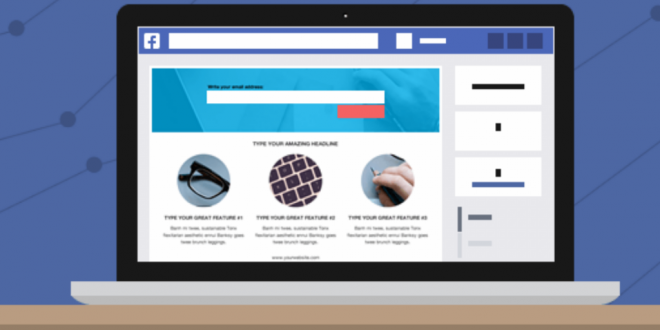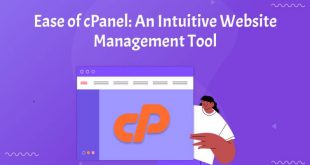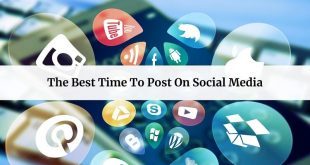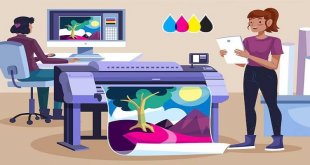In marketing your business, reaching as many people as possible also increases the chances of growing your customer base. To do that, you’re likely looking to market on Facebook. As the most used social media platform, with over 2 billion users, Facebook is not only the single biggest community you can promote your business, product or service to, it is also one of if not the most profitable, generating tens of billions of dollars in ad revenue.
That means Facebook users click a lot of ads, but that means nothing if you don’t convince them to engage with your business afterward. Enter the Facebook landing page. In this article, we will learn about landing pages, how integrating them into your marketing strategy benefits you, as well as some tips and examples to create a catchy and effective Facebook landing page.
What is a Facebook Landing Page?
A Facebook landing page is a website (or web page, if you will) that your Facebook ads redirect to when visitors click on them. By association, landing pages are created specifically for marketing or advertising use, with the goal of “converting” your visitors into paying customers or leads.
Unlike a traditional home page or a respective page on your website, landing pages are often designed around a single purpose or goal, making them more suited for achieving intended responses from your visitors.
Think of landing pages as your very own salesperson: a good one can tell you everything you need to know about a specific brand, product or service, and they make it easy for you to make that purchase. The best part: landing pages don’t bother you unless you ask! In this case, that’s when visitors click on your ad.
Why is a Facebook Landing Page important?
1. Ads alone lack information.
There’s only so much real estate on a single picture, so you want to reserve that for the most attractive bit of information to entice users to click. After that though, users will want to know more about whatever got them to click on the ad in the first place. Time for your landing page to shine!
Designed well, your landing page analyzes the visitors exactly why they should be interested in your business, how to get started, and only that. Otherwise, you risk losing business because visitors feel lost, frustrated, or worse, misled, which is not what you spent your ad money for.
2. Traditional websites have too much information.
On the other end of the spectrum, most marketers likely won’t consider a home page or any permanent part of your website an effective landing page because they don’t often direct your visitors to a specific goal. Instead, regular websites contain detailed, necessary information about your business, your products and/or your services and all the ways they can navigate your site. Its focus is on informing visitors rather than encouraging action, which is the ideal response to your Facebook marketing campaign.
When you redirect from an ad to a regular web page, again you risk losing your viewer’s attention, and that’s a critical mistake because…
3. The average user is easily distracted.
When talking about marketing on Facebook (or any platform, for that matter) we must understand and stay up-to-date on consumer and competitor behavior.
In 2020, Facebook earned a whopping $20.7 billion in ad revenue.
Of that number, mobile ads are responsible for 94% of that revenue.
It makes sense then, to aim for success in Facebook’s mobile ad space. But mobile users aren’t easy pickings either.
It’s been reported that the average attention span has fallen to eight seconds today. Couple that with the instant gratification and the overwhelming number of distractions that the common smartphone can provide, and you have a tiny window in which to attract, inform and convert your mobile user into a paying customer. Considering the lack of and the overload of information that our first two points have, landing pages provide a solid middle ground. One thing is for sure: it’s all about making it as convenient as possible for users to do business with you.
Facebook Landing Page Rules
So now you want to create a landing page, and that’s great. But you can’t just put anything on your landing page – you need to make sure you comply with Facebook’s policies around them. They provide a comprehensive outline of those policies which apply to both ads and landing pages, but here are some of the most basic rules to get you started:
1. Comply with Facebook’s advertising policies.
We cannot state this enough. You’re trying to launch an ad campaign on Facebook, which means you play by their rules. Make sure you read the rules linked above, especially if you work in a more sensitive industry, like alcohol or weight loss. Certain industries have additional requirements attached to them, so it’s best to read up if you’re unsure.
2. Provide what was advertised.
Nobody wants to be misled, and this is especially true for paying customers. Your landing page must make the same offer that your ads do – even something as simple as offering a digital coupon when your ad promises a physical copy of a product can be grounds for your ad to be rejected, or your account shut down. We don’t want that.
3. Let users act on your offer.
Automation on your landing pages can get your ad shut down. Users must manually engage with your CTA on the landing page, instead of having the landing page automatically open external sites or begin a file download. This is true even if your ad is encouraging users to visit a site or download a file.
Think of this as similar to pestering your visitors with an offering; if you design your products and your marketing materials well enough, they will come to you instead, which is exactly the behavior we are trying to attract.
4. Stick to one ad layer.
Do not punish your users when attempting to monetize your landing page itself. Visitors must be able to immediately interact with your landing page, which means ad pop-ups are not allowed. Apart from it being a cause for rejection, this aligns with the entire purpose of your landing page in the first place, which is to get your user through the customer journey as fast as possible from interested passerby to willing consumer. Any content that also makes it difficult for users to navigate away from your site is a red flag.
5. Show your privacy policy.
This is a more recent addition to our list, to make sure that you comply with increasingly stricter data privacy laws when creating your Facebook landing page. A privacy policy explains to your users how their data will be used and stored, among other things, and creating one does not have to be difficult, or a manual process. WordPress has a plugin called WP AutoTerms which generates a Privacy Policy and Terms of Service document for you to use on your landing page or website by answering some questions. The best part: it’s free!
Bonus: Make sure your landing page works.
All of that effort would be for nothing if your page didn’t work properly. For starters, you cannot attach a landing page that’s not yet finished. Technical issues such as slow or broken pages when loading are also reasons for Facebook to shut down the ad. So make sure you’re prepared to launch the page before attaching it to your campaigns.
How to Create Catchy Facebook Landing Page
After ensuring compliance, you’ll want to ensure that your ad stands the greatest chance of converting visitors to leads. While there is no “right way” to build your page, carefully observing examples from other industries hint at some effective strategies:
1. Build around the goal of your ad.
Not all landing pages are the same, especially when it comes to your CTA. As we said previously, it’s important to align your landing page with your ad. So it creates a natural progression in the customer journey, including the conversion. For example, adding handy links to commonly available calendars is a perfect match when your landing page is encouraging users to sign up for event newsletters. A call to register an account would be a much faster conversion when Facebook or Google login buttons were also provided.
Your copy also goes a long way toward creating that continuity. It’s important to keep it short, sweet and on point, while still giving your visitors everything they need to know about your product or service. Being more specific and focusing on what your users get is a lot more effective than telling them what you want them to do.
2. Create consistent, high-quality visuals.
No marketing strategy today is complete without visuals to back it up. Not only do they draw more attention to your ad, but your visuals also help greatly in establishing credibility and trust with your audience. First, your visuals must be consistent throughout the entire journey. This is not just limited to your ad banner and your landing page, it extends to your main brand page and your website as well, from your Facebook cover photo, and profile picture to the banners, buttons, and supporting graphics across your entire website.
One of the most basic ways to do this is with your logo. Make it visible across most, if not all, of your graphics. The picture you used in your ad also makes for a good highlight on your landing page itself. Between all of them, your color choices are another subtle way to create consistency across the material, and this can easily be achieved by creating the visuals yourself.
We understand that if you don’t have a creative background, this could be intimidating but it doesn’t have to be. Having a handy photo editor makes this process much easier than you might think. Photoshop is the go-to photo editor for most, but other options such as Pixelied are also available; not only do they cost relatively less to use, they have a more streamlined photo editor, with templates designed and optimized for social media.
If not that, you can also look to hire a professional or freelance photo editor or designer, which removes much of the tedium, though your mileage may vary, as the time saved making them yourself could be replaced by a long hiring process.
3. Use video to show off your product in action.
Some products are much easier to market just by looking at them – for others. You might need to give your visitors just a little bit more to fully show off the power of your product or service. In this case. A well-put-together video makes for an excellent alternative on your landing page.
Video allows you to better show off that your product not only works but is also designed to meet your user’s needs. Remember though to still keep it focused and brief, as a video does require a bit more attention from your users. We already know they don’t stick around for very long to be convinced, so let’s make it count.
4. Incentivize your call to action.
Another way to further reduce friction between your product and your potential customer is to give them a little extra in between. This is prominent in e-commerce, where it makes sense to offer discounts or free shipping to your first users. With services and tools, free trials can be especially attractive, especially when it’s a no-commitment offer. Matterapp.com is a good example of this.
While this is also their home page, the basic elements of a good Facebook landing page are present here. A compelling sales pitch (“One app to replace them all.”), supporting visuals and an incentivized trial. Immediately, they tell you that the app is free to use forever even without a credit card which removes most if not all barriers to entry. It saves for actually registering for an account. From there, they then offer a trial for paid features, which are designed to trickle up from the Free plan. Which by itself already offers the simplicity and variety of features that a typical user might need.
5. Show social proof. Establish credibility.
It’s one thing to show off your product. It’s even better when you have happy customers to prove it (assuming you have them, of course. Don’t be tempted to fake this section!) If you can build a compelling first view using the above tips. You can then expand your Facebook landing page to include some of your most recognizable customers or partners.
Bonus: Be reachable.
Besides the essentials above, consider the possibility that your visitors might still need to know more about what you can offer. This is yet another opportunity for you to ease the customer journey by making your contact details and options available and easily understood on the Facebook landing page.
Takeaway
Landing pages help bridge the gap between users clicking on an ad on your Facebook page to completing purchases, subscribing to newsletters. Any other actions you intend for your marketing campaign to achieve. By arming yourself with knowledge on tips, tools, and rules for making a catchy Facebook landing page. You stand to maximize the cost of your ad campaigns by converting visitors to actual leads. Apply these learnings to your next campaign today.
Author’s Bio:
Shelly has been involved in digital marketing projects since 2009. Currently, she works as an outreach specialist and SEO. She co-founded SaaSLaunchr.com, a digital marketing agency offering guest posting services, search engine optimization, and content writing for a Software as a Service company.
 free html design Free html design templates
free html design Free html design templates






